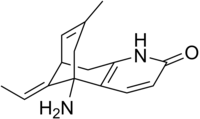Huperzine A
 | |
 | |
| Clinical data | |
|---|---|
| Other names | HupA |
| Routes of administration | Oral |
| ATC code | |
| Pharmacokinetic data | |
| Elimination half-life | 10-14h[1] |
| Identifiers | |
| |
JSmol) | |
| Melting point | 217 to 219 °C (423 to 426 °F) |
| |
| |
| | |
Huperzine A is a naturally-occurring
Pharmacological effects
Huperzine A is extracted from Huperzia serrata.[2] It is a reversible acetylcholinesterase inhibitor[6][7][8][9] and NMDA receptor antagonist[10] that crosses the blood–brain barrier.[11] Acetylcholinesterase is an enzyme that catalyzes the breakdown of the neurotransmitter ACh and other choline esters that function as neurotransmitters. The structure of the complex of huperzine A with acetylcholinesterase has been determined by X-ray crystallography (PDB code: 1VOT; see the 3D structure).[12]
Huperzine A has been investigated as a possible treatment for diseases characterized by neurodegeneration such as Alzheimer's disease,[2][13] and there is some evidence from small-scale studies that it can benefit cognitive functioning, global clinical status, and ability to engage in activities of daily living (ADLs) among individuals with the disease. In a 2016 systematic review of systematic reviews,[14] huperzine A was associated with a standardized mean difference of 1.48 (95% CI, 0.95-2.02) compared to placebo on measures of ADL among people with dementia, but the evidence was very low-quality and uncertain. In a 2022 umbrella review,[15] huperzine A was associated with broad benefits to dementia patients' cognitive functioning, but the degree of heterogeneity in measurements and outcomes of the reviewed studies indicated publication bias toward huperzine A benefit.
Adverse effects
Huperzine A may present with mild cholinergic side effects such as nausea, vomiting, and diarrhea.[5] Slight muscle twitching and slurred speech might also occur, as well as excessive saliva excretion and sweating. The use of huperzine A during pregnancy and lactation is not recommended due to the lack of sufficient safety data.[16]
Drug interactions
Huperzine A may have
Safety
Huperzine A, in spite of the possible cholinergic side effects, seems to have a wide margin of safety. Toxicology studies show huperzine A to be non-toxic even when administered at 50-100 times the human therapeutic dose. The extract is active for 6 hours at a dose of 2 μg/kg with no remarkable side effects.[19]
Other possible uses
Huperzine A might be useful in the treatment of organophosphate nerve agent poisoning by preventing damage to the central nervous system caused by such agents. [20] [21]
Synthesis
Two scalable and efficient total syntheses of huperzine A have been reported.[22][23]
References
- S2CID 2702029.
- ^ S2CID 36435892.
- PMID 20731560.
- PMID 24086396.
- ^ PMID 18425924.
- PMID 16364207.
Huperzine A (HupA), a novel alkaloid isolated from the Chinese herb Huperzia serrata, is a potent, highly specific and reversible inhibitor of acetylcholinesterase (AChE).
- ISBN 978-0-275-98394-9.
- S2CID 8655284.
- .
- PMID 18588864.
- PMID 9951045.
- S2CID 236518.
- PMID 10637369.
- PMID 27121704.
- S2CID 245311001.
- ^ "Huperzine A". Natural Standard: The Authority on Integrative Medicine. Natural Standard. Retrieved 29 October 2014.
- PMID 10754762.
- PMID 9052690.
- PMID 12164543.
- ^ "Review of the Value of Huperzine as Pretreatment of Organophosphate Poisoning". Nutrition Review. 22 April 2013.
- PMID 15952670.
- S2CID 98224866.
- .
